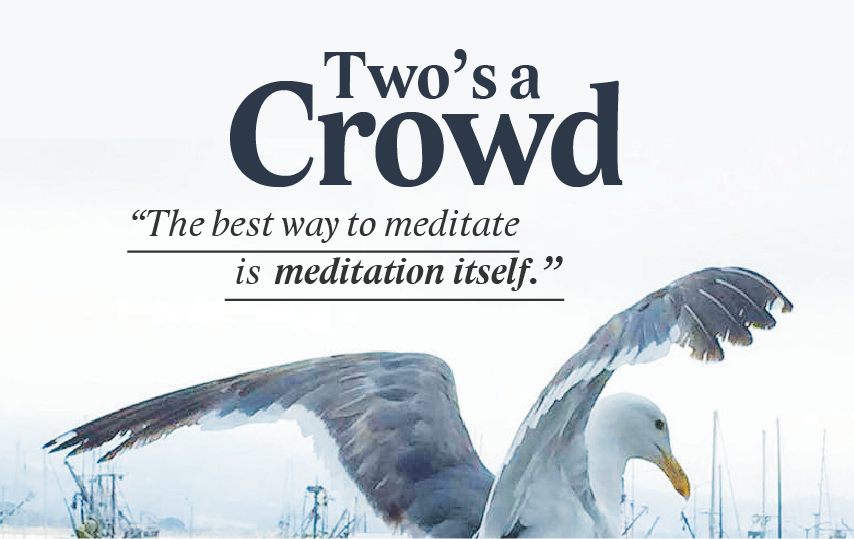Meditation is not a huge undertaking. Anybody can do it anywhere they are, anytime they want, sitting somewhere familiar or even on the fly. It’s often thought that meditation is thinking about nothing. It’s not, since thinking is one thing and nothing is another thing.
If you’re trying to think about nothing, you are still thinking, giving your best shot to making something out of nothing. But, trying to think of nada is like trying to nail Jell-O to a wall. Only nothing comes from nothing. The black hole of meditation isn’t the dark side of the void.
The practice is about being somebody somewhere in a state of being less and less distracted, especially by thoughts. That’s why there are walking and sitting meditations, in the park or on a park bench. It’s not about inflatable obstacle course the moving body. It’s about the non-moving mind. It’s about slowing down the brain on the train.
“If you’re impatient while waiting for the bus,” said Gretchen Rubin, author of The Happiness Project, “tell yourself you’re doing bus waiting meditation.”
It’s about knowing everything without thinking about anything, at the same time that it’s about paying close attention to one thing, the one thing you’re doing on the spot you’re doing it.
It’s about being alone.
But, who wants to be alone? Many people hate being alone. It makes them feel insecure anxious depressed. They get into relationships and marriages and stay related and married because they’re afraid of being alone. We seek family, work, and obligations to stave off loneliness. Social isolation poses health risks and is associated with an increased risk of death.
Most people avoid being alone as much as possible because who wants to hear the voices in their own head all day long, their own internal monologue. You can’t get away from yourself. It would drive anyone crazy.
Even the Bible says it’s not good for man to be alone, although Jean Paul Sartre, the existentialist writer, once said hell was other people. Whenever you’re left alone you have fewer problems. It’s harder to find someone else to blame, though.
Meditation is an old practice, prehistoric, mentioned in some Hindu texts more than three thousand years ago, and practiced by pagans, Christians, and Muslims. The Romans said, “Do what you are doing.” Japan’s Zen is meditative, Sufis practiced meditative breathing controls, and a meditative tradition is implicit in the Jewish Tanakh.
The bones of it all come from the Buddhists. “Many techniques commonly practiced today originate from ancient Buddhist meditation texts,” explained Susan Chow, a science writer and editor. For most of its long history it was a religious approach. Even when it wasn’t it played a top spot in many religious and spiritual practices.
Believers went to churches temples mosques for many years centuries millennium to affirm and reaffirm their beliefs. They prayed and meditated because it was the person-to-person way to talk to God. It was the direct line to heaven. If you wanted to go to heaven you went to church first.
But, who goes to church anymore? Religion was once called the opiate of the masses. However, denominations and church attendance have slowly and steadily declined the past thirty years, so that today, according to The Journal for the Scientific Study of Religion, only about 52 million worshipers go to a weekly service.
Yoga is the new opiate of the masses. It has grown by leaps and bounds the past thirty years, so that today, according to Yoga Journal, about 37 million Americans practice it. Getting on their rubber mats about twice a week, at a studio or at home, means that more people practice yoga than go to church every week.
Spiritual practice has gone rubber soul secular.
Nobody wants to climb the Holy Staircase of the Scala Santa in Rome on sore knees anymore. Everybody wants to get down on healthy knees for cat cow pose. Nobody wants to chant a mantra to a complicated-sounding deity. Everybody wants to go ecstatic kirtan dancing at Wanderlust. Nobody wants to meditate like old-school Buddhists, for whom meditation was a cog in the machinery of enlightenment, along with virtue and wisdom.
Virtue and wisdom don’t get it done anymore, dude, not in the machine age.
What does get it done is mindfulness meditation.
“Meditation is not religion, not spirituality, it’s a technology of upgrading the mind that can enrich one’s life,” wrote Jay Michaelson in ‘Evolving Dharma: Meditation, Buddhism, and the Next Generation of Enlightenment’.
Mr. Michaelson cut to the chase, limning his perspective on meditation and its offspring, modern mindfulness meditation. “There are a lot of same-old, same-old Buddhist jumpers for sale books out there. I wanted to write the book I wanted to write, for my circle of serious practitioner friends, all of whom are either Gen-X or Millennial, and none of whom have any patience for those clichés.”
“All men’s miseries derive from not being able to sit in a quiet room alone,” wrote Blaise Pascal, the French mathematician and philosopher, coining a cliché.
But, three hundred years after Blaise Pascal, nobody needs to sit in a musty quiet same-old room meditating all by themselves. Besides, it’s not a quiet world anymore, not when the nagging question of the age for the Gen-X and Millennial body politic is, “Where’s my iPhone?” We have turned our backs on silence, even though it’s only silence that can express the inexpressible.
To read the full article please download our Asana Journal App or purchase Issue 166 October 2016.




















 Other
Other
Edward, I love these lines. Succinct critical evaluation, and that’s good.
Nobody wants to climb the Holy Staircase of the Scala Santa in Rome on sore knees anymore. Everybody wants to get down on healthy knees for cat cow pose. Nobody wants to chant a mantra to a complicated-sounding deity. Everybody wants to go ecstatic kirtan dancing at Wanderlust.